Learn How to Read Sheet Music for Violin Games
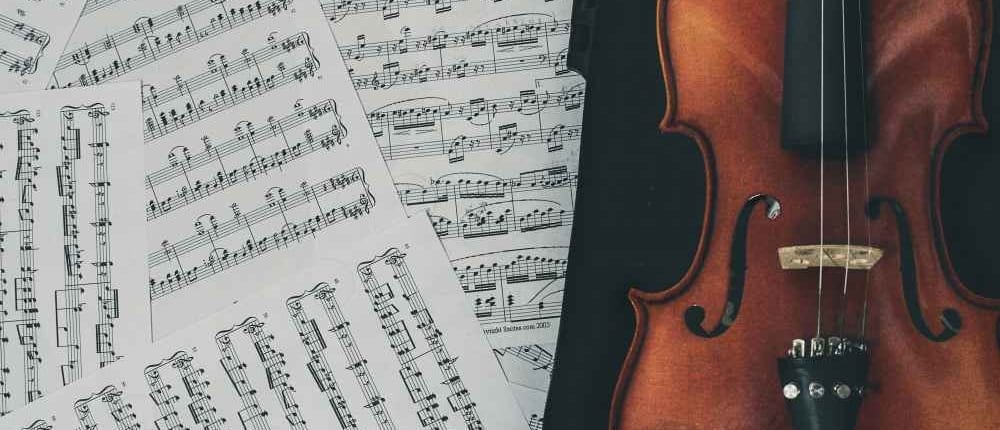
Learning how to read violin sheet music is a challenging but important job.
Being able to read music off of the folio unlocks an entire world of musical potential. When you develop your sight-reading skills, playing a new piece of music can be as like shooting fish in a barrel as reading these words.

Learn Piano in Private Lessons: In-Person or online
Cheque it Out!
Playing by ear is a wonderful and valuable skill that can come up in handy in many situations, peculiarly when it comes to improvising. All the same, learning how to readviolin sheet music is necessary if you aspire to perform with an orchestra, quartet, or band.
Once yous've learned how to read violin notes , you'll be able to play any slice of music you set your mind to. Learning a new slice is exponentially easier when y'all can interpret the sheet music. The skillful news is that you tin larn how to read music while building up other fundamental violin techniques such equally scales, finger positions, and bowing .
Below, we volition walk you through how to read violin sheet music and so test your knowledge with a quick quiz.
How to Read Violin Canvass Music : Step by Step
The Staff
The journey of learning how to read sail music starts with the staff. The staff is the set of v horizontal lines on which notes are placed in standard violin sheet music.
There are seven notes of which all music is based: A, B, C, D, E, F and G. One time yous get to One thousand, yous would offset back over with A and the cycle would repeat once again, getting higher in pitch every bit you go up the staff.
There are also multiple pitches that stand for with the same letter in music. For instance, there are several different A's on the violin. They are just in varying forms of higher or lower pitches.
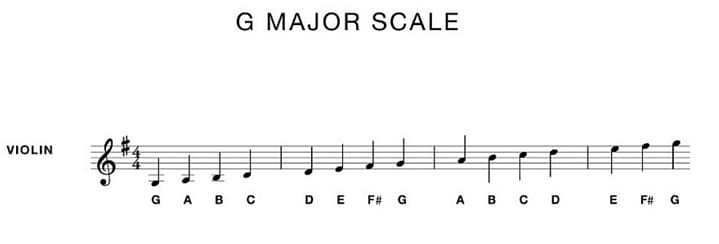 The Notes on the Lines
The Notes on the Lines
The easiest fashion to larn violin music notes is to carve up the staff up into lines and spaces.
These are the notes that autumn on the lines of the staff, pregnant the notes direct on peak of the lines, with the lines intersecting them.
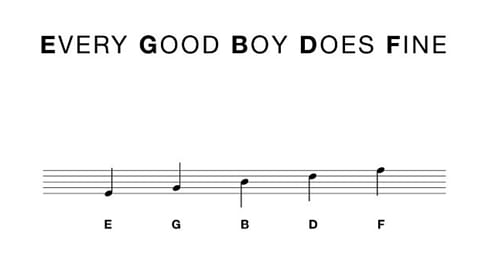
Starting from the lesser line, begin to memorize each note going upwards the top line. One popular mnemonic device you may have heard is "Every Good Boy Does Fine." Some other is "Elvis' Guitar Broke Downwardly Friday."
These devices tin be really handy to help y'all memorize the notes! You can besides commencement with a beginner violin volume, such as Essential Elements for Strings Book I, which volition give you some great exercises to help you memorize and larn these notes.
The Notes on the Spaces
Adjacent, there are the violin music notes that fall in between the lines – on the spaces:
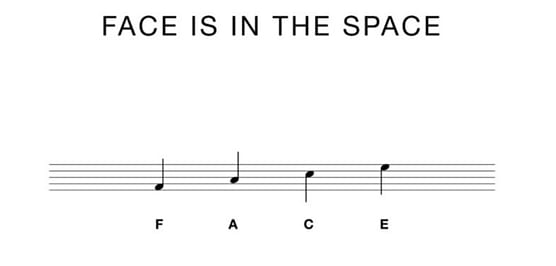
Another keen mnemonic device applies here. If you lot wait at the notes starting from the bottom note up to the top annotation, you will run into that the letters spell F-A-C-E. And that of grade rhymes with infinite. It's quite catchy and memorable: "Face is in the space!"
Whenever y'all're practicing or working from an exercise book make sure to continue these mnemonic devices in heed. If you forget the proper noun of a note, first determine whether the note falls on a space or a line.
So take your finger or a pencil and bespeak to each notation from the bottom on up, while saying aloud the respective mnemonic device to refresh your memory. See, learning how to read violin notes isn't that hard subsequently all!
RELATED: Beginner'south Guide to Tuning a Violin
Ledger Lines
The five lines and four spaces aren't quite enough to contain the entire spectrum of violin notes. In order to place these violin music notes, we use small lines or dashes chosen "ledger lines." The notes tin can autumn on the lines or in the spaces between them merely like the five lines of the staff.
In the Grand scale chart above, you'll discover that in that location are other notes that fall below the staff (lower in pitch) and above the staff (college in pitch.)
To read these notes y'all tin can utilise the ones on the staff that you already know equally a reference point to figure them out.
Of import Symbols on the Staff
A very of import part of learning how to read violin notes is memorizing the unlike symbols you might come beyond on the staff. If you lot await over some violin sail music or an exercise volume, you'll observe some new symbols at the beginning of each staff line.

The Treble Clef
You may recognize the fancy swirly symbol at the start of the staff as a clef. Clef symbols are reference points that proper noun a specific note on the staff from which the names of all the other notes are based.
Lower pitched instruments employ other clefs with different reference points, such every bit bass or alto clef. But in violin (equally well as higher pitched instruments such every bit flute and trumpet) we use the treble clef.
The master thing a beginner should take from this is that if yous're looking at canvas music with a treble clef on it, it signifies that the music is suitable to be played on the violin.
Key Signature
Next, yous'll come across the key signature, which is very important to pay attending to because it volition tell you whether or not you have whatsoever flat or sharp notes in the vocal.
- A flat note (i.due east. B flat) is a half-step lower in pitch than the base annotation (B) and is signified by this symbol: ♭
- A precipitous note (i.e. C precipitous) is a one-half-step higher in pitch than the base of operations note (C) and is signified past this symbol: #

If you encounter a flat symbol in the key signature, look at the line or infinite that is striking through the centre of the symbol and determine which notation corresponds to the line or infinite.
Now throughout the duration of the piece (whether information technology'south a higher or lower version of that note) y'all will be playing the flat version of that note.
The same goes for when you see a precipitous symbol in the key signature. Take a close look at the precipitous symbol and observe that at that place is a little skewed square correct in the center of the symbol.
Whichever note corresponds to the line or space that the foursquare forms around will exist the note that will get abrupt throughout the piece.
Sometimes at that place will be multiple sharps or a combination of sharps and flats. If you don't run into any sharps or flats in your key signature, you can just assume that all the notes in the piece are going to be your normal or "natural" notes.
Whatever notes that are not mentioned in the key signature are causeless to exist natural notes every bit well.
Time Signature
Next in line is the fourth dimension signature. The fourth dimension signature lets you know how to count a slice or how many beats are in each measure.
The staff is divided by vertical lines into segments called "measures," which will contain a certain number of beats depending on what your time signature says.
The elevation number in the time signature tells you how many beats are in each measure. Once the allotted number of beats have been counted out, it's time to move on to the next measure and start the counting over once again.
The bottom number describes the length of the beat out. If yous have a four on the bottom (virtually common) that would signify that you are basing your beat off of the length of a quarter annotation.
These are the numbers you'll be seeing on the bottom of the time signature and which annotation lengths they correspond to:
- two = half note
- iv = quarter notation
- 8 = eighth note
- 16 = sixteenth note
These are the most common fourth dimension signatures y'all will see:

The 4/iv fourth dimension signature is so mutual that it is referred to as "mutual time" and often, y'all will see a C on the music where the fourth dimension signature would ordinarily be which means to play the piece in 4/iv fourth dimension.
SEE Too: The Pros and Cons of the Suzuki Method
Quiz Yourself on How to Read Violin Notes
At present that you empathise all the symbols and signatures at the beginning of a violin song, you're ready to showtime reading notes.
Remembering your mnemonic devices tin help yous read the notes on the staff, but will you be able to identify the notes that autumn off the staff?
Every bit discussed earlier, there are many notes that volition fall above the staff and a couple that fall below it.
Just think that if you know the notes on the staff, y'all tin count up or down using the alphabet to figure out any note you come across.
Test yourself with the chart below.
Starting with the top line, which you know is an F, count upwardly alphabetically to figure out what note this is. Make sure you count each space and line!
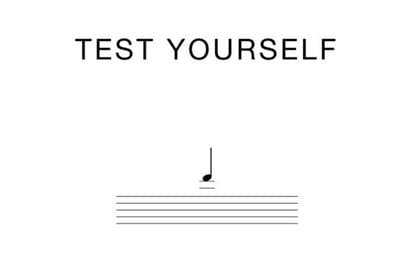
If you guessed D, you're right!
At present that you lot understand the basics of how to read violin notes , yous're ready to start putting it all together . You can at present begin to learn about how these notes on written sheet music correspond to the notes on your violin, which is discussed thoroughly inthis article.
While we covered a lot of information in this mail service, online resources such as these are no substitute for a violin teacher. Your teacher tin can provide you with a personalized, pace-by-step approach to mastering how to read violin sheet music , while answering any questions yous may have along the way.
If you're looking to ameliorate your musical skills from the comfort of your own abode, online violin lessons are a not bad selection. Your teacher tin share their screen and explain the diverse elements of canvas music in a fun and attainable fashion. Through real-time feedback, yous can develop proper playing habits and make the most out of your time on the instrument.
The time you spend learning how to read music is well worth it. The more than you practice, the more the notes will jump off the page and onto your violin!
 Post Writer: Naomi Cherie Southward.
Post Writer: Naomi Cherie Southward.
Naomi teaches violin in Austin, TX. She is a classically trained violinist with over 20 years of experience and a various musical background. Learn more most Naomi Cherie S. here.
Source: https://takelessons.com/blog/how-to-read-violin-notes-guide-z08
Post a Comment for "Learn How to Read Sheet Music for Violin Games"